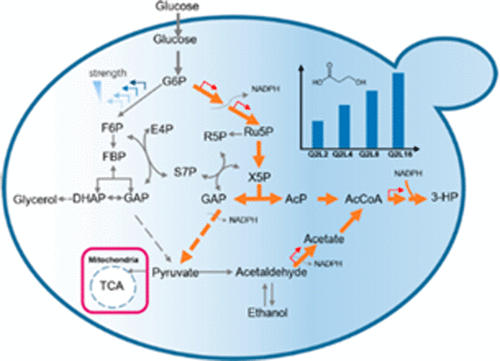当前位置:
X-MOL 学术
›
ACS Synth. Biol.
›
论文详情
Our official English website, www.x-mol.net, welcomes your
feedback! (Note: you will need to create a separate account there.)
Rewiring Central Carbon Metabolism Ensures Increased Provision of Acetyl-CoA and NADPH Required for 3-OH-Propionic Acid Production
ACS Synthetic Biology ( IF 3.7 ) Pub Date : 2020-11-13 , DOI: 10.1021/acssynbio.0c00264 Ning Qin 1 , Lingyun Li 1 , Xu Ji 1 , Xiaowei Li 2 , Yiming Zhang 1 , Christer Larsson 2 , Yun Chen 2 , Jens Nielsen 1, 2, 3 , Zihe Liu 1
ACS Synthetic Biology ( IF 3.7 ) Pub Date : 2020-11-13 , DOI: 10.1021/acssynbio.0c00264 Ning Qin 1 , Lingyun Li 1 , Xu Ji 1 , Xiaowei Li 2 , Yiming Zhang 1 , Christer Larsson 2 , Yun Chen 2 , Jens Nielsen 1, 2, 3 , Zihe Liu 1
Affiliation

|
The central carbon metabolite acetyl-CoA and the cofactor NADPH are important for the synthesis of a wide array of biobased products. Here, we constructed a platform yeast strain for improved provision of acetyl-CoA and NADPH, and used the production of 3-hydroxypropionic acid (3-HP) as a case study. We first demonstrated that the integration of phosphoketolase and phosphotransacetylase improved 3-HP production by 41.9% and decreased glycerol production by 48.1% compared with that of the control strain. Then, to direct more carbon flux toward the pentose phosphate pathway, we reduced the expression of phosphoglucose isomerase by replacing its native promoter with a weaker promoter, and increased the expression of glucose-6-phosphate dehydrogenase and 6-phosphogluconate dehydrogenase by replacing their native promoters with stronger promoters. This further improved 3-HP production by 26.4%. Furthermore, to increase the NADPH supply we overexpressed cytosolic aldehyde dehydrogenase, and improved 3-HP production by another 10.5%. Together with optimizing enzyme expression of acetyl-CoA carboxylase and malonyl-CoA reductase, the final strain is able to produce 3-HP with a final titer of 864.5 mg/L, which is a more than 24-fold improvement compared with that of the starting strain. Our strategy combines the PK pathway with the oxidative pentose phosphate pathway for the efficient provision of acetyl-CoA and NADPH, which provides both a higher theoretical yield and overall yield than the reported yeast-based 3-HP production strategies via the malonyl-CoA reductase-dependent pathway and sheds light on the construction of efficient platform cell factories for other products.
中文翻译:

重新连接中心碳代谢可确保增加生产3-OH-丙酸所需的乙酰辅酶A和NADPH
中央碳代谢物乙酰辅酶A和辅因子NADPH对于多种生物基产品的合成很重要。在这里,我们构建了一个平台酵母菌株以改善乙酰辅酶A和NADPH的提供,并以3-羟基丙酸(3-HP)的生产为例进行了研究。我们首先证明,与对照菌株相比,磷酸酮醇酶和磷酸转乙酰酶的整合将3-HP产量提高了41.9%,并将甘油产量降低了48.1%。然后,为了将更多的碳通量导向戊糖磷酸途径,我们通过用较弱的启动子替换其天然启动子来降低磷酸葡萄糖异构酶的表达,并通过替换它们的天然启动子来增加葡萄糖6-磷酸脱氢酶和6-磷酸葡萄糖酸酯脱氢酶的表达。具有较强启动子的启动子。这使3-HP产量进一步提高了26.4%。此外,为了增加NADPH的供应,我们过表达了胞质醛脱氢酶,并将3-HP产量提高了10.5%。结合最优化的乙酰辅酶A羧化酶和丙二酰辅酶A还原酶的酶表达,最终菌株能够产生3-HP,最终效价为864.5 mg / L,与传统方法相比提高了24倍以上。起始应变。我们的策略将PK途径与氧化性戊糖磷酸途径相结合,以有效提供乙酰辅酶A和NADPH,这比已报道的基于酵母的3-HP生产策略提供了更高的理论产量和总产量 并将3-HP产量再提高10.5%。结合最优化的乙酰辅酶A羧化酶和丙二酰辅酶A还原酶的酶表达,最终菌株能够产生3-HP,最终效价为864.5 mg / L,与传统方法相比提高了24倍以上。起始应变。我们的策略将PK途径与氧化性戊糖磷酸途径相结合,以有效提供乙酰辅酶A和NADPH,这比已报道的基于酵母的3-HP生产策略提供了更高的理论产量和总产量 并将3-HP产量再提高10.5%。结合最优化的乙酰辅酶A羧化酶和丙二酰辅酶A还原酶的酶表达,最终菌株能够产生3-HP,最终效价为864.5 mg / L,与传统方法相比提高了24倍以上。起始应变。我们的策略将PK途径与氧化性戊糖磷酸途径相结合,以有效提供乙酰辅酶A和NADPH,这比已报道的基于酵母的3-HP生产策略提供了更高的理论产量和总产量通过丙二酰辅酶A还原酶依赖性途径,为其他产品的高效平台细胞工厂的建设提供了启示。
更新日期:2020-12-18
中文翻译:

重新连接中心碳代谢可确保增加生产3-OH-丙酸所需的乙酰辅酶A和NADPH
中央碳代谢物乙酰辅酶A和辅因子NADPH对于多种生物基产品的合成很重要。在这里,我们构建了一个平台酵母菌株以改善乙酰辅酶A和NADPH的提供,并以3-羟基丙酸(3-HP)的生产为例进行了研究。我们首先证明,与对照菌株相比,磷酸酮醇酶和磷酸转乙酰酶的整合将3-HP产量提高了41.9%,并将甘油产量降低了48.1%。然后,为了将更多的碳通量导向戊糖磷酸途径,我们通过用较弱的启动子替换其天然启动子来降低磷酸葡萄糖异构酶的表达,并通过替换它们的天然启动子来增加葡萄糖6-磷酸脱氢酶和6-磷酸葡萄糖酸酯脱氢酶的表达。具有较强启动子的启动子。这使3-HP产量进一步提高了26.4%。此外,为了增加NADPH的供应,我们过表达了胞质醛脱氢酶,并将3-HP产量提高了10.5%。结合最优化的乙酰辅酶A羧化酶和丙二酰辅酶A还原酶的酶表达,最终菌株能够产生3-HP,最终效价为864.5 mg / L,与传统方法相比提高了24倍以上。起始应变。我们的策略将PK途径与氧化性戊糖磷酸途径相结合,以有效提供乙酰辅酶A和NADPH,这比已报道的基于酵母的3-HP生产策略提供了更高的理论产量和总产量 并将3-HP产量再提高10.5%。结合最优化的乙酰辅酶A羧化酶和丙二酰辅酶A还原酶的酶表达,最终菌株能够产生3-HP,最终效价为864.5 mg / L,与传统方法相比提高了24倍以上。起始应变。我们的策略将PK途径与氧化性戊糖磷酸途径相结合,以有效提供乙酰辅酶A和NADPH,这比已报道的基于酵母的3-HP生产策略提供了更高的理论产量和总产量 并将3-HP产量再提高10.5%。结合最优化的乙酰辅酶A羧化酶和丙二酰辅酶A还原酶的酶表达,最终菌株能够产生3-HP,最终效价为864.5 mg / L,与传统方法相比提高了24倍以上。起始应变。我们的策略将PK途径与氧化性戊糖磷酸途径相结合,以有效提供乙酰辅酶A和NADPH,这比已报道的基于酵母的3-HP生产策略提供了更高的理论产量和总产量通过丙二酰辅酶A还原酶依赖性途径,为其他产品的高效平台细胞工厂的建设提供了启示。











































 京公网安备 11010802027423号
京公网安备 11010802027423号